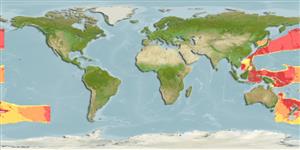Environment: milieu / climate zone / depth range / distribution range
Écologie
marin bathypélagique; profondeur 892 - 966 m (Ref. 95664). Deep-water
Distribution
Pays | Zones FAO | Écosystèmes | Occurrences | Point map | Introductions | Faunafri
Western Pacific: Japan and Philippines.
Taille / Poids / Âge
Maturity: Lm ? range ? - ? cm
Max length : 36.6 cm TL mâle / non sexé; (Ref. 40777)
Description synthétique
Clés d'identification | Morphologie | Morphométrie
Épines dorsales (Total) : 0; Rayons mous dorsaux (Total) : 17 - 18; Épines anales: 0; Rayons mous anaux: 14 - 15. Body elongate and subcylindrical. Mouth very large and oblique, maxillary extending below posterior margin of eye. Lower jaw much projected beyond the upper, and provided with a pointed bony knob at symphysis directed forward and downward. Transverse scales very few, about 13 (Ref. 559). Scales deciduous. Pyloric caeca 21 (Ref. 40777).
Collected with an otter trawl (Ref. 95664).
Life cycle and mating behavior
Maturité | Reproduction | Frai | Œufs | Fécondité | Larves
Masuda, H., K. Amaoka, C. Araga, T. Uyeno and T. Yoshino, 1984. The fishes of the Japanese Archipelago. Vol. 1. Tokai University Press, Tokyo, Japan. 437 p. (text). (Ref. 559)
Statut dans la liste rouge de l'IUCN (Ref. 130435: Version 2024-2)
Menace pour l'homme
Harmless
Utilisations par l'homme
Pêcheries:
Outils
Articles particuliers
Télécharger en XML
Sources Internet
Estimates based on models
Preferred temperature (Ref.
123201): 3.3 - 3.4, mean 3.3 °C (based on 3 cells).
Phylogenetic diversity index (Ref.
82804): PD
50 = 0.5078 [Uniqueness, from 0.5 = low to 2.0 = high].
Bayesian length-weight: a=0.00347 (0.00163 - 0.00737), b=3.19 (3.00 - 3.38), in cm total length, based on LWR estimates for this (Sub)family-body shape (Ref.
93245).
Niveau trophique (Ref.
69278): 3.5 ±0.5 se; based on size and trophs of closest relatives
Résilience (Ref.
120179): Milieu, temps minimum de doublement de population : 1,4 à 4,4 années (Preliminary K or Fecundity.).
Fishing Vulnerability (Ref.
59153): Low to moderate vulnerability (27 of 100).
